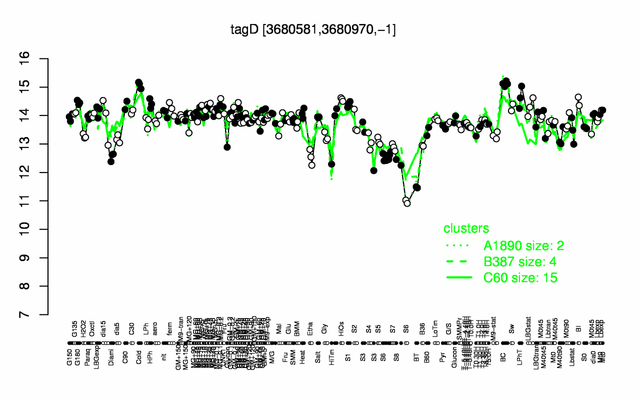TagD
Revision as of 14:15, 17 April 2014 by 134.76.70.252 (talk)
- Description: glycerol-3-phosphate cytidylyltransferase
| Gene name | tagD |
| Synonyms | |
| Essential | yes PubMed |
| Product | glycerol-3-phosphate cytidylyltransferase |
| Function | biosynthesis of teichoic acid |
| Gene expression levels in SubtiExpress: tagD | |
| Metabolic function and regulation of this protein in SubtiPathways: TagD | |
| MW, pI | 15 kDa, 5.672 |
| Gene length, protein length | 387 bp, 129 aa |
| Immediate neighbours | tagE, tagA |
| Sequences | Protein DNA DNA_with_flanks |
Genetic context 
This image was kindly provided by SubtiList
| |
Expression at a glance PubMed
| |
Contents
Categories containing this gene/protein
cell wall synthesis, biosynthesis of cell wall components, essential genes
This gene is a member of the following regulons
The gene
Basic information
- Locus tag: BSU35740
Phenotypes of a mutant
essential PubMed
Database entries
- BsubCyc: BSU35740
- DBTBS entry: [1]
- SubtiList entry: [2]
Additional information
The protein
Basic information/ Evolution
- Catalyzed reaction/ biological activity: CTP + sn-glycerol 3-phosphate = diphosphate + CDP-glycerol (according to Swiss-Prot)
- Protein family: cytidylyltransferase family (according to Swiss-Prot)
- Paralogous protein(s):
Extended information on the protein
- Kinetic information:
- Domains:
- Modification:
- Cofactor(s):
- Effectors of protein activity:
- Localization:
- cytoplasm (according to Swiss-Prot)
Database entries
- BsubCyc: BSU35740
- UniProt: P27623
- KEGG entry: [3]
- E.C. number: 2.7.7.39
Additional information
Expression and regulation
- Additional information:
- The mRNA has a long 5' leader region. This may indicate RNA-based regulation PubMed
- number of protein molecules per cell (minimal medium with glucose and ammonium): 604 PubMed
- number of protein molecules per cell (complex medium with amino acids, without glucose): 2215 PubMed
- number of protein molecules per cell (minimal medium with glucose and ammonium, exponential phase): 751 PubMed
- number of protein molecules per cell (minimal medium with glucose and ammonium, early stationary phase after glucose exhaustion): 656 PubMed
- number of protein molecules per cell (minimal medium with glucose and ammonium, late stationary phase after glucose exhaustion): 811 PubMed
Biological materials
- Mutant:
- Expression vector:
- lacZ fusion:
- GFP fusion:
- two-hybrid system:
- Antibody:
Labs working on this gene/protein
Your additional remarks
References